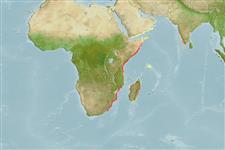>
Eupercaria/misc (Various families in series Eupercaria) >
Caesionidae (Fusiliers) > Caesioninae
Etymology: Caesio: Latin, caesius, bluish-grey, 1835; it is the same name given to the silvery metal (Cs) (Ref. 45335); xanthalytos: Name from Greek, literally meaning 'yellow line'; referring to the prominent deep yellow band along the fish’s midside; noun in apposition.
Environment: milieu / climate zone / ລະດັບຄວາມເລິກ / distribution range
ນິເວດວິທະຍາ
ສັດທະເລ; ນ້ຳກ່ອຍ pelagic-neritic; ລະດັບຄວາມເລິກ 8 - 40 m (Ref. 94071). Tropical
Western Indian Ocean: Kenya (purchased in Mombasa market), Tanzania (Dar es Salaam), southern Mozambique and KwaZulu-Natal (Margate, 30°51' S), southern Madagascar (Ref. 94071); and a new record from the Laccadive Arch. (Ref. 130907).
ຂະໜາດ / ນ້ຳໜັກ / Age
ການຈະເລີນເຕັມໄວ: Lm ? range ? - ? cm
Max length : 22.0 cm SL ຕົວຜູ້/ບໍ່ມີເພດ; (Ref. 94071)
Short description
ຕົວທີ່ໃຊ້ໃນການຈຳແນກຊະນິດ | ສະລີລະວິທະຍາ | ການວັດແທກຮູບຮ່າງລັກສະນະພາຍນອກຂອງດິນ,ສັດ,ປາ…
ຄີ (ໜາມ)ແຂງຢູ່ຫຼັງປາ (ທັງໝົດ) : 10; ຄີຫຼັງຂອງປາ (ຄີອ່ອນ) (ທັງໝົດ) : 15; ຄີ(ໜາມ) ແຂງຢູ່ຄີກົ້ນປາ
ກຸ່ມປາກະດູກແຂງ
ຄວາມຖີ່ຂອງກຸ່ມຖ່າຍທອດພັນ
ປາທີ່ມີການເຄື່ອນຍ້າຍຈາກທະເລໄປຫານ້ຳຈືດ ແລະນ້ຳຈືດຫາທະເລ
ປາທີ່ມີການເຄື່ອນຍ້າຍຈາກທະເລແລະໄປໄຂ່ຢູ່ນ້ຳຈືດ
ຄີກົ້ນຂອງປາ
ສັດທີ່ມີກະດູກສັນຫັຼງ
ການຖ່າຍທອດທາງກຳມະພັນຈາກພໍ່ແມ່ຫາລູກ: 3; ຄີກົ້ນຂອງປາ: 11 - 12; ສັດທີ່ມີກະດູກສັນຫຼັງ: 23. This medium-sized species is distinguished by the following: a prominent, composite, yellow lateral band in life, bordered by irregular dark brown stripes, and with a narrow blue stripe in the yellow, above the lateral line; the lateral line is within band for most of length; 19-22 pectoral-fin rays (rarely 19 or 21, 22); 57-67 (mode 59-62) lateral line scales; 11-12 (mode 11) anal fin rays; 8 + 12 circumpeduncular scales (Ref. 94071).
Body shape (shape guide): fusiform / normal; Cross section: compressed.
This species schools with Caesio variliniata and both have been observed together in large shoals in northern KwaZulu-Natal. Prolific spawning in the Park Rynie area, KwaZulu-Natal (30°20’ S, 30°45’ E) is apparent due to abundance of eggs of this species from plankton collections (Ref. 94071).
Life cycle and mating behavior
ການຈະເລີນເຕັມໄວ | ການສືບພັນ | ການວາງໄຂ່ | ໄຂ່ | ຄວາມດົກຂອງໄຂ່ປາ | ຕົວອ່ອນ
Holleman, W., A.D, Connell and K.E. Carpenter, 2013. Caesio xanthalytos, a new species of fusilier (Perciformes: Caesionidae) from the Western Indian Ocean, with records of range extensions for several species of Caesionidae. Zootaxa 3702(3):262-272. (Ref. 94071)
IUCN Red List Status (Ref. 130435: Version 2024-2)
Threat to humans
Harmless
Human uses
ການປະມົງ: ເປັນສີນຄ້າ
ເຄື່ອງມື
Special reports
Download XML
ແຫຼ່ງອີນເຕີເນັດ
Estimates based on models
Preferred temperature (ເອກະສານອ້າງອີງ
123201): 24.7 - 27.5, mean 26.7 °C (based on 42 cells).
Phylogenetic diversity index (ເອກະສານອ້າງອີງ
82804): PD
50 = 0.5010 [Uniqueness, from 0.5 = low to 2.0 = high].
Bayesian length-weight: a=0.01288 (0.00577 - 0.02877), b=3.09 (2.90 - 3.28), in cm total length, based on LWR estimates for this (Sub)family-body shape (Ref.
93245).
ຊັ້ນເຂດຮ້ອນ (ເອກະສານອ້າງອີງ
69278): 3.4 ±0.4 se; based on size and trophs of closest relatives
ຄວາມຢືດຢຸ່ນ (ເອກະສານອ້າງອີງ
120179): ສູງ, ປະຊາກອນຕຳ່ສຸດທີ່ໃຊ້ເວລາສອງໜ້ອຍກວ່າ 15 ເດືອນ (Preliminary K or Fecundity.).
Fishing Vulnerability (Ref.
59153): Low vulnerability (17 of 100).
🛈
